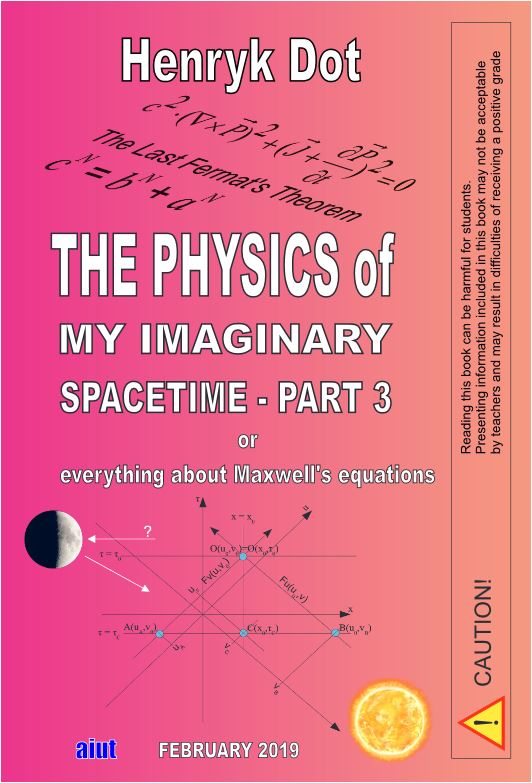is the online companion to a series of books published by AIUT under the common main title
"Physics of My Imaginary Space-Time" by Henryk Dot.
Physics 3 - Maxwell
Note from the Author
Table of Contents
What is this book
Historical facts
New aspects
Fully erroneous
Incorrectly interpreted
Physics 3 - Chapter 1
Equations
Complex vectors form
The Most General form
The General Solution
Physics 3 - Chapter 2
Solutions
Initial conditions
Non-homogeneous equation
Solution for three-directions
The four laws
Physics 3 - Supplement
Fermat's proof
Beal's conjecture
Pythagorean triples
Inertial mass
Gravity constans big G
What does the Moon look at?
Physics 3 - Final notes
Final notes
Physics 4 - New book
Entry
"Subject" should begin with
a digit corresponding to the day
of the week., e.g. Sunday=7
Books published by AIUT
are found in libraries according to the list of compulsory copies.
Second Edition of "Fizyka 3"
ISBN 978-83-926856-1-6

can be bought in Warsaw
in the Academic Bookstore
PW Publishing House
Noakowskiego street 18/20
and in Katowice
in the bookstore "Liber"
Bankowa street 11.
(area of Silesian University)
English edition of "Physics"
ISBN 978-83-926856-2-3

is also in libraries
and the distribution method should be asked wydawca@aiut.com.
|
3.1.1 Andrew Beal’s conjecture This proof is also applicable for Andrew Beal’s conjecture. |
|
| |
(3.6) |
|
and the proof results directly from equation (3.3), which has no solution for natural numbers s = bNb + aNa and x other than zero. We can see that according to Beal’s conjecture all exponents for a, b and c can be different but for a and b have common odd divisor. We should clarify now the case when x=(a+b) – c=0 |
|
| |
(3.7) |
|
thus |
|
| |
(3.8) |
|
The left side of the equation contains only one component:
s to the power of Nc.
The expression on the right side in square brackets can be divisible by
s |
|
| |
(3.8a) |
|
The lack of divisibility of these last two components by s2
eliminates purposefulness of further exponent increase for
s as this being a divisor for N.
The same applies for second possible divisor of N,
which would have to be divisible by s
and then an exponent could be increased. Max exponent for s
as being a divisor of N could be
N−1, but then expression in square brackets would be negative.
It would become negative already at lower values of exponent for s.
|
|
| |
(3.8b) |
|
We can conclude then that Nc=2 and N=s.
The equality: s2= NN=(N − a)N+aN,
must be verified and it is only fulfilled for N=3. This explains the single case: |
|
© 2020 Henryk Dot -
